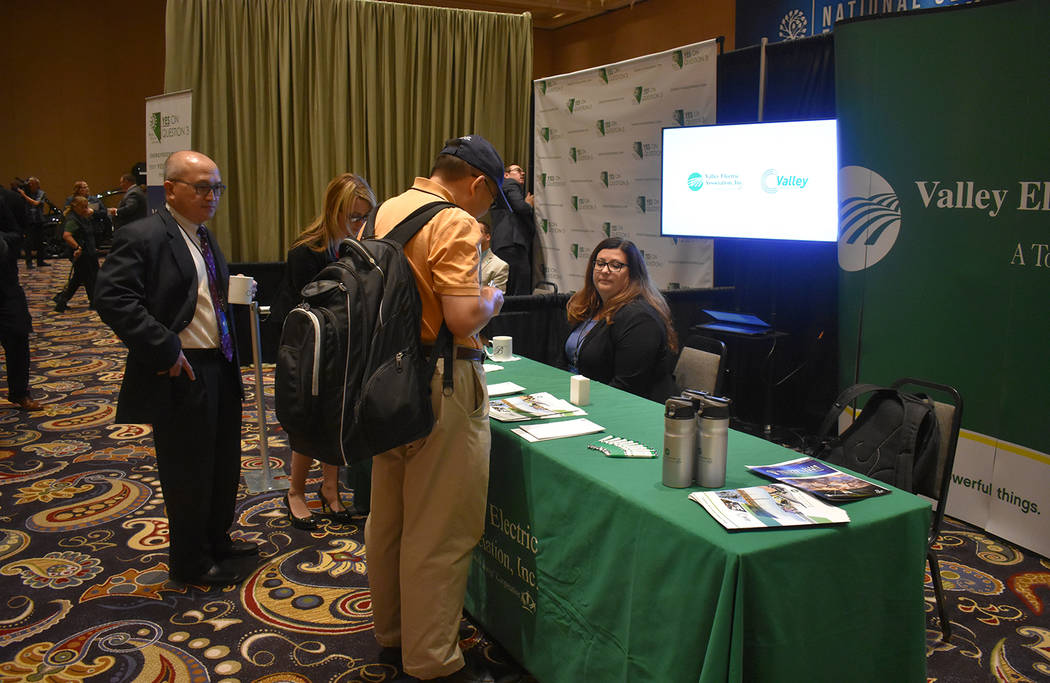
Tom Husted, Valley Electric Association CEO, took the stage at the National Clean Energy Summit in Las Vegas on Friday along with renewable energy advocates and stakeholders from around the country, including former Vice President Al Gore.
The event, which was hosted by Nevada Gov. Brian Sandoval and former U.S. Sen. Harry Reid, D-Nevada, was focused on the economic, environmental and security benefits of clean energy, and brought former Vice President Gore and former Energy Secretary Ernest Moniz, among other prominent speakers, to the Bellagio in Las Vegas.
Husted and Chris Deschene, energy attorney of the Navajo Nation, a Native American tribe that occupies portions of Arizona, Utah and New Mexico, talked about the role of clean energy in rural communities during their 12-minute discussion.
Husted said the relationship formed between Valley Electric and the Las Vegas Paiute Tribe several years back allowed the cooperative to run its multi-million transmission line through tribal land, and in turn, gave tribal members access to transmission.
“We were completing a $100-million transmission project, and there’s an $80-million transmission project,” Husted said. “And that required us to form a partnership or relationship with the Las Vegas Paiute Tribe in order to take that line across their land. As part of that partnership, the tribe now has an option in the future of possibly taking power or obtaining communication services from Valley Electric.”
“So if they own their own tribal utility, there’s a utility that’s willing to help them,” Husted said. “There’s transmission assets that are there, ready to serve them also with the communications.”
Husted praised the cooperative’s success with the Las Vegas Paiute Tribe and said it was possible because Valley Electric and the chair of the tribe were able to sit down and negotiate.
“That’s what allows us to be innovative in doing things that we are doing and to form those relationships with the consumers,” Husted said.
Utility of tomorrow
Husted said Valley Electric’s innovative ability allowed the co-op to put in programs that allowed it to be more efficient, resulting in lower costs for consumers.
“Many utilities today tout their smart meters,” Husted said. “We are getting ready to put in fourth-generation smart meters, and now we are hooking that up to our fiber-optic system. So why did we use smart meters 15-20 years ago? It was because of innovative affordability that we had with our business model that now allows us to put in a system that right away allows us to reduce outage time by 75 percent.”
Answering Deschene’s question about what a utility of tomorrow would look like in rural communities, Husted said Valley Electric is envisioning a vertically-integrated industry with generation, transmission down to distribution.
“We are going to see an industry that’s now horizontal in which we will work side by side in all of those aspects,” Husted said. “And the fiber-optics is a key to that. Really two components are driving that, one is technology and the other one is the mindset of the consumer.”
“So we see in the future that we are not going to be in this dictator type of decision, but we are going to be the conductor of this orchestra through the utilization of where energy is coming, where energy is going, how we are distributing that, and how we are working with the consumer who might be buying power from us and selling power at the same time,” Husted said.
Valley Electric’s future undertakings
Valley Electric, which serves the rural area roughly the size of New Jersey, is on track to make Beatty its first all fiber-optic community in Nevada.
In an interview with the Pahrump Valley Times following his speech, Husted said that by the end of the year, Beatty will have a complete fiber-optics line.
“Starting in Pahrump, we got work going on in Tonopah. When we get regulatory approvals, we will start Sandy Valley, so all the communities within our service area will see the advancement of high-speed communications, and that ties into them having the ability to change not only their lives, but then their energy consumption patterns,” Husted said.
Valley Electric originated more than 50 years ago and has since evolved in response to consumer habits.
“First, it was energy, which is critical infrastructure, and now it’s communications,” Husted said. “And they really work hand-in-hand because as technology continues to develop, then we are going to be controlling, monitoring and doing all these great things with our homes, businesses, with energy through communications. So, that’s a really symbiotic relationship.”
Contact reporter Daria Sokolova at dsokolova@pvtimes.com. On Twitter: @dariasokolova77